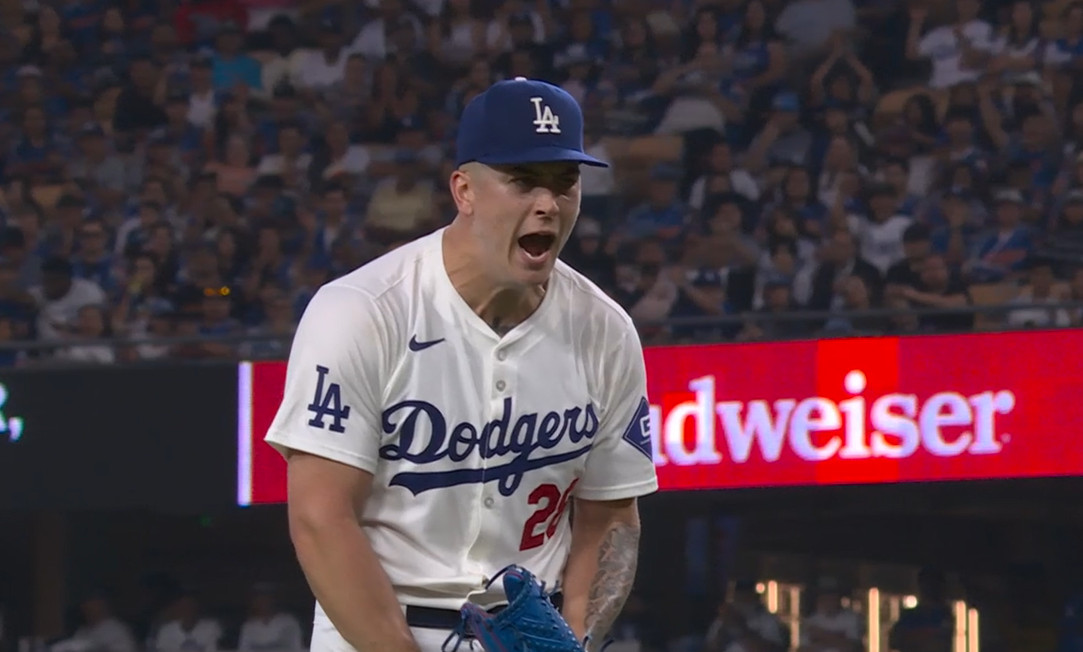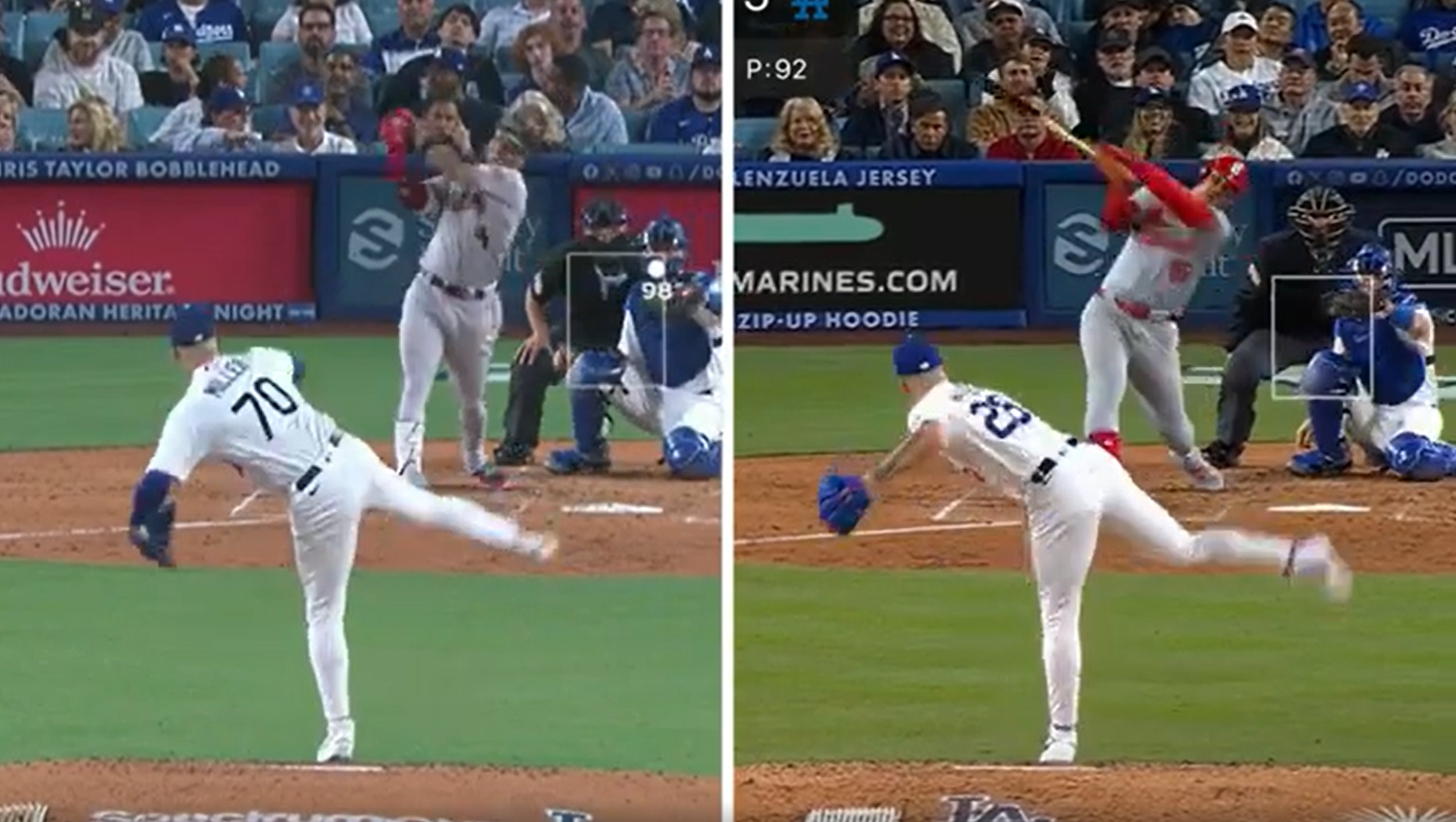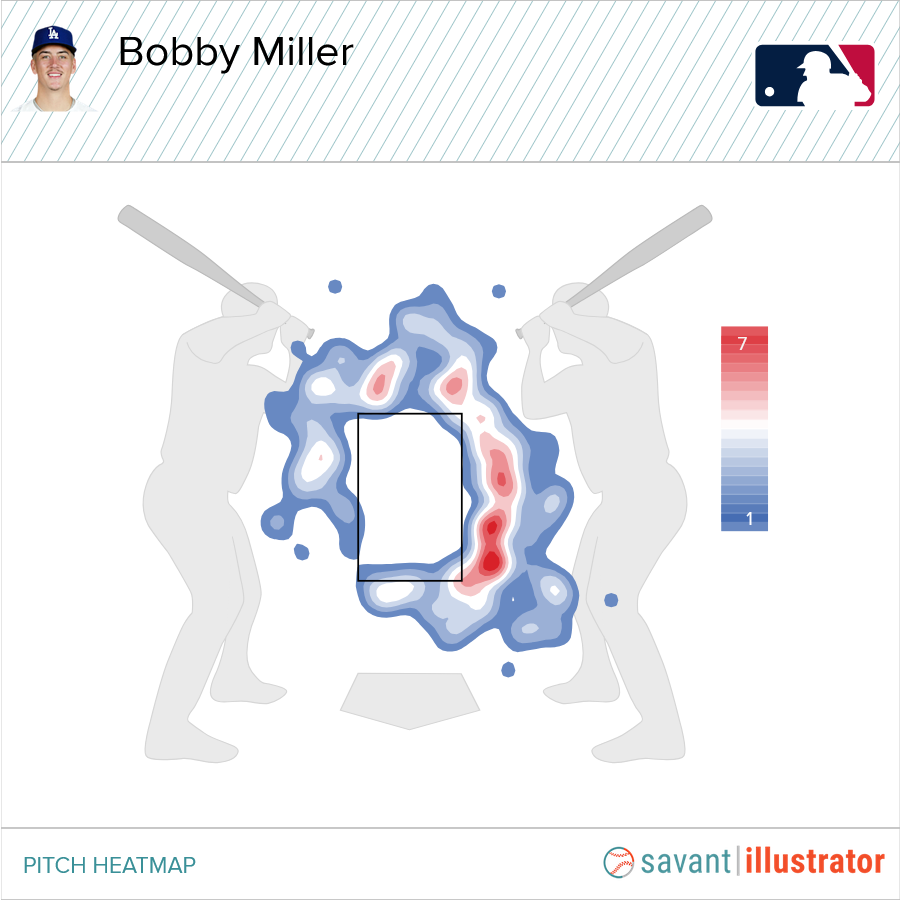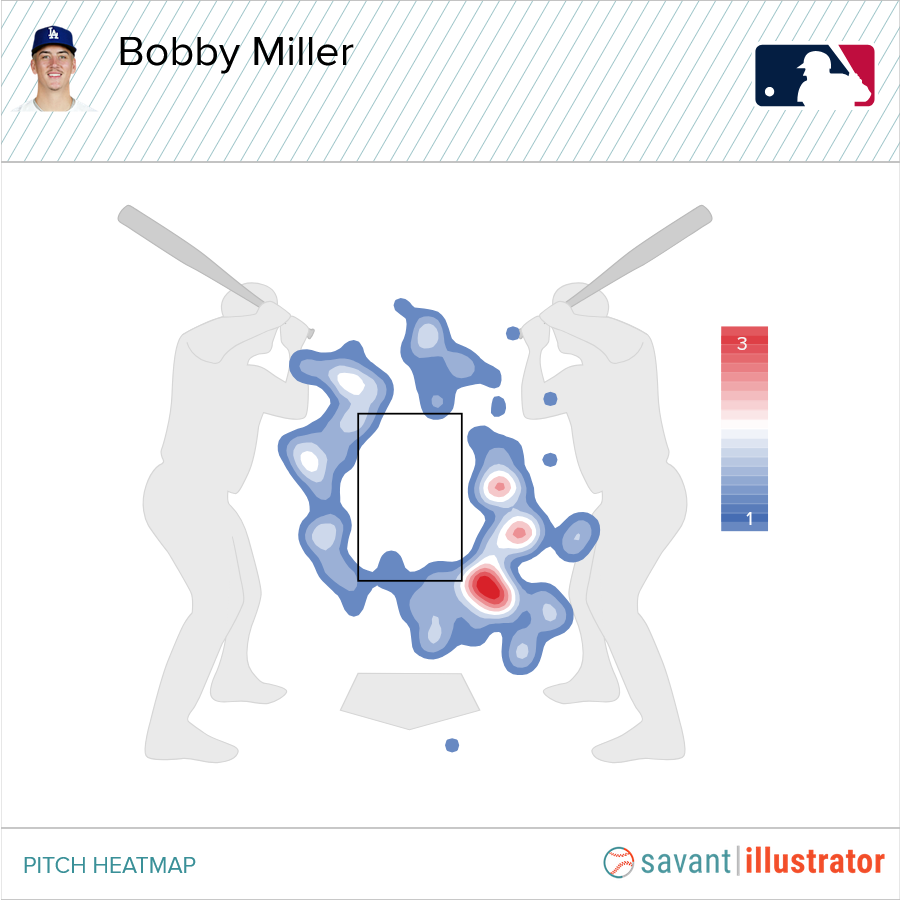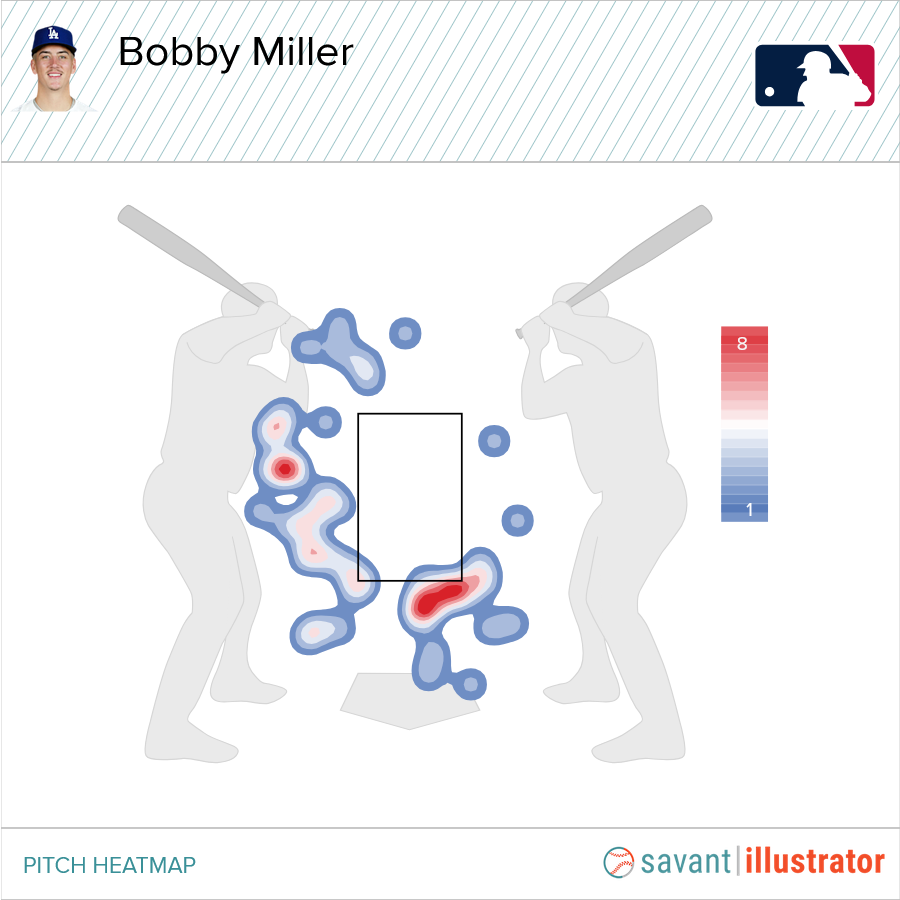After a 2023 campaign during which Bobby Miller led the club in pitcher fWAR and looked like a future ace at times, his follow-up season was a complete disaster. He was sidelined for a couple months with a shoulder injury, then returned to post an ERA north of 8.00, a FIP and xERA around 7.00, nearly double the walk rate of 2023 (6.3% to 11.1%), and more than triple the homer frequency (0.87 HR/9 to 2.73). The best thing you could say is that he helped Dave Roberts get his steps in, what with all the pacing and mound visits the 25 year-old elicited.
So what gives? How did 2023’s wunderkind go backwards so quickly and so completely? Let’s have a look.
——
So much of pitching is based off of fastball command, and a repertoire is built with pitches that, ideally, bear enough of a resemblance out of a pitcher’s hand that the batter is not able to differentiate between a tunneling duo. They move in concert on the edges of the zone, coyly darting away from each other’s paths, only to meet again in the hurler’s glove, ready to cut up the 60-foot, 6-inch dance floor time and again.
Bobby Miller, 100mph Fastball and 87mph Slider, Overlay pic.twitter.com/TKHpolIS5o
— Rob Friedman (@PitchingNinja) May 24, 2023
Bobby Miller, 99mph Fastball (swinging strike) and 80mph Curveball (backwards K), Overlay.
— Rob Friedman (@PitchingNinja) March 25, 2024
That's fair. pic.twitter.com/ncxvIW4vdw
When he has that going, good luck.
Unfortunately for us Dodger fans, that was a rare occurrence in 2024, and there may be a mechanical reason behind that. Miller’s fastballs got absolutely shellacked: the xwOBA against his four seamer rose from .315 to .461 (!). That difference, 146 points, is about the same as the difference between facing Shohei Ohtani and Chris Taylor (.448 vs .298, 150 points). Yeesh.
First, let’s here’s a side by side of two four-seamers, full speed and slowed down with two pauses. On the left from September of 2023, and on the right, from March of 2024, before he was sidelined with the shoulder malady. (I chose March because, ostensibly, that was when he was best-positioned out of camp after his offseason for the new campaign. His later season looks will be addressed below.)
From the jump, you can see that he has moved from setting up on the first base side of the rubber to the middle of the rubber, which may been a contributing factor (will revisit this in a couple paragraphs). Anyway, at the first pause, note that he previously sat down on his back leg and separated his hands a tick sooner, and at the second pause, the bottom of his arm swing in 2024, while it follows about the same path from 2023, is lagging. That switch is accompanied by a slight change in shoulder alignment angle relative to the plate, though the arm swing change is definitely greater, which brings me to the concerning part about this mechanical difference.
Two pauses again. First pause, note how in 2023 the ball is up sooner, and at the second pause, in 2024 you can barely see the Dodgers script on the front of his jersey; you can even see the elbow on his glove arm coming through while the ball and his arm are still well behind, compared to 2023 where his glove is still visible just beyond his chest.
In short, his arm is a little late, and he is opening too early, exacerbating the issue, and further evidence is provided by the aforementioned setup. It’s fine if you change your setup, and it often can have tremendous benefits, if thoughtfully executed with respect to repertoire and usage. In Miller’s case, it could certainly work, if everything moved with it. Unfortunately, it did not:
Despite setting up a good six or eight inches farther towards third, Miller’s landing foot is in roughly the same spot, maybe an inch or two different from what it was. This isn’t necessarily bad on its own, but it is evidence that his angle towards the plate has changed quite a bit, which may not be working with everything else he has going on.
To sum, Miller went from having a touch of crossfire in his delivery, where the landing foot is across the pitcher’s center line from the rubber to home — which may have aided in keeping him closed — to having no crossfire, which could be a contributor to opening up too soon. To be fair, crossfire can also put stress on the shoulder, so this looks like a well-intended adjustment that went pear-shaped.
——
When you open up too soon like Miller did in 2024, there are some negative effects. One, it puts stress on the front of your throwing shoulder. The muscles are stretched beyond what they should be and simultaneously have to work to get the arm to catch up to the rest of his body, the stress of which was borne out in Miller’s situation by a long IL stint. And two, it compromises command.
The command is a tricky part because it doesn’t necessarily show up in some of the data we have come to rely upon, namely, spin axis and arm angles, and those remained the same across these two seasons; 1:00 spin axis, 47° arm angle. Where does it show up then? In part, spray pattern.
These are just four-seam fastballs that were called for a ball. I am not looking at fastballs in the zone because I am looking for intent (or lack thereof), and when it comes to heat maps, a get-me-over middle/middle fastball is the same as trying to paint the black and missing by half a plate width, whereas clusters of misses can sort of reveal how and whether a pitcher may be working to set up a batter.
First, here are four seam fastballs that were called for a ball in 2023:
Fastballs up and out of the zone over the corners, from which one can get chases if a batter finds it too tantalizing to resist, or, if they lay off, it’s a prime condition from which to attack with a curve. Additionally, fastballs off the plate away to righties/in to lefties, which can be paired with a changeup or sinker running back in off the edge to either, or a slider to righties whose initial trajectory has it catching more plate but ultimately getting Manny Machado to wave at something in the lefty batters box.
(Heh.)
But, when the arm is late, the angle of attack of the baseball to the plate can and often does change. This is true whether the arm remains late throughout, leading to misses up and arm side, or whether the act of catching up carries the path of the ball beyond the plate, leading to misses low and away, which the map of 2024’s misses bears out:
The high fastball over the plate has all but disappeared, and the main concentration of heaters is in a position that does little good — a tunnel off that spot with any of his other pitches is an obvious ball as well.
When you look at the map of his sinker, the escalating unproductive nature of the misses becomes even more stark. First in 2023:
And now, in 2024:
Misses increasingly way off the plate in, an area that does nothing for the subsequent pitch, growing misses low and away, of a height that is of little use with the rest of his secondaries. The best thing you could say is that he could tunnel a four-seamer off a sinker down there to catch the bottom of the zone, assuming he could spot up. Which he couldn’t.
Now, if you are howling that a miss doesn’t always reveal intent, you are correct! But pitchers work with what’s there, and, as mentioned, a miss in a good spot is an opportunity from which to work. I am positing that his misses do little but leave him behind in the count, and searching for a way to attack, as opposed to having multiple clear avenues.
——
I have always maintained that if my #NotAScout ass notices something, the club was on it ages prior. Its their lives and livelihoods, and Mark Prior and Co. likely don’t need to pore over video to pick up the above. That said, the assumption on my part is that they knew and attempted to work through this mechanical issue, giving him every opportunity to have it click, much as they did with Walker Buehler, who so handsomely rewarded them for their faith. And, sure enough, if you flash forward to Miller’s promising start against Tampa in August, there are adjustments in place.
Another video, full speed, and then slowed down with two pauses:
Note from the start that Miller is back to being set up on the first base side of the rubber. At the first pause, his hips are facing towards home, you can still see the “D” from the “Dodgers” script across his chest, showing that he is staying more closed with his upper body, while getting hip to shoulder separation. Unfortunately, he is a tad at odds with himself, as you can see his glove arm coming through, but this is just a single frame in a 30 FPS video. While this doesn’t hold true for all of his late-season pitches, he is definitely, at times, very close.
At the second pause, note the location of the left foot — it is a good bit farther to the left than it was in 2023 when he was also starting on the first base side of the rubber, indicating that this adjustment is a bit of a compromise; Miller is getting the starting position that helped him stay closed, while ditching the crossfire that may have contributed to his shoulder woes. And lastly, the location — the target is low, his pitch is a miss, but it stayed in its lane and is a vertical miss, as opposed to the clusters above that indicated he was missing East/West. Ideally you don’t miss on a 3-2 count, but it is the kind of miss from which a pitcher can work, and when you have big stuff, you can often afford to just divide the plate in half.
——
There are other factors in play here, like losing a tick and a half of velo, and his slider, whether intentionally or not, losing its vertical break and having a more horizontal action to it. And, although his overall Stuff+ dropped from 123 in 2023 to 113 in 2024, had he enough innings to quality, the latter would have still ranked 5th in all of MLB, which is eye-opening considering the results. But it’s not throwing, it’s pitching; the filth was there, but filth isn’t always enough.
That said, they were tinkering throughout the season, and this is fixable. The obvious task for this offseason should be to build off the preseason 2024 goals and shore up the 2024 mechanical compromise in a way that helps him effectively his locate his fastball, while putting him in a position that aides in arm/shoulder health. He still has five total offerings that grade out by Stuff+ as league average or better, they just need to be dancing to the same tune; the foundation needs to be strong, and the fastball has to take the lead.
 Dodgers Digest Los Angeles Dodgers Baseball Blog
Dodgers Digest Los Angeles Dodgers Baseball Blog
